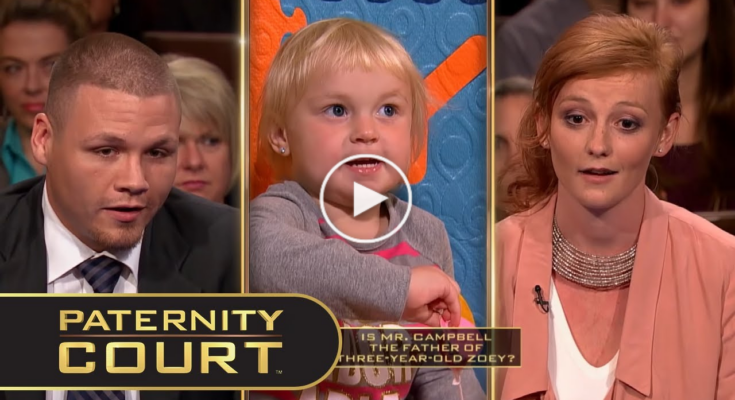The central narrative of this episode revolves around a complex and emotionally charged case. A man named Mr. Campbell is seeking a DNA test to prove that he is the father of Miss Hopper’s daughter, Zoey. Mr. Campbell passionately states, “Finding out if I am Zoey’s father is important. Being her father has given me a reason to make better decisions.” This statement sets the stage for a heated and contentious dispute, instantly drawing viewers into the heart of the conflict.
Miss Hopper, however, presents a conflicting narrative. She initially told Mr. Campbell that he was the father but later changed her mind, causing confusion and tension in the courtroom. This flip-flopping on such a crucial matter adds a layer of intrigue to the unfolding drama, leaving viewers eager to uncover the truth.
Another man named Jason is also involved in the case. Jason claims that he was told by Miss Hopper that he could be the father of her child, but he denies being the father. He explains, “Miss Hopper initially told me not to worry because the child wasn’t mine, but later told me I could be the father.” This revelation adds another layer of complexity to the case, as Jason also contends for the potential role of Zoey’s father. The fact that Zoey calls him “daddy” on FaceTime further complicates the situation, raising questions about the nature of their relationship.
The presiding judge, demonstrating an objective and balanced approach, questions both parties about the nature of their relationships and the timeline of events. The judge also probes Jason about his relationship with Miss Hopper and another man at the same time. Jason admits to seeing both of them at the same time and suggests that he thought it could be possible that both he and the other man could be the father. This admission raises questions about the validity of his claims and the potential implications for Zoey’s paternity.
The climax of the episode arrives with the revelation of the results of a DNA test. The test confirms that Mr. Campbell is not the father of the three-year-old girl, Zoey. This revelation brings a sense of resolution to the intense dispute and validates Miss Hopper’s claims. The moment is charged with emotion, as the truth finally comes to light, and the parties involved must grapple with the reality of the situation.
Despite the results, Mr. Campbell expresses a desire to be involved in Zoey’s life. The judge emphasizes the importance of establishing a relationship between the child and their biological father and urges Mr. Campbell to take responsibility. The judge advises, “It’s important to establish some type of communication with the girl’s biological father.” This advice underscores the show’s commitment to the welfare of the child, who is often the most affected in these disputes.
In addition to urging Mr. Campbell to accept his responsibilities, the judge also suggests seeking counseling and resources to navigate the complex emotional landscape that such situations often entail. This advice underscores the show’s commitment to not only resolving paternity disputes but also ensuring the well-being of all parties involved, especially the child.
In conclusion, this episode of Paternity Court presents a compelling narrative of a paternity dispute, complete with emotional turmoil, heated arguments, and a final revelation. It underscores the complexities of such situations and the importance of responsibility and truth in resolving them. The episode serves as a stark reminder of the potential consequences of casual relationships and the importanceof clear communication. It also emphasizes the critical role of DNA testing in establishing paternity, thereby ensuring the child’s right to know and have a relationship with their biological father.
The episode is a microcosm of the real-life drama that unfolds in countless families across the world. It showcases the human capacity for denial, the desperate need for truth, and the profound impact that these paternity issues can have on all parties involved. The emotional rollercoaster that Mr. Campbell, Miss Hopper, and Jason ride throughout the episode is a testament to the complex dynamics that can arise from situations like these.
The judge’s role in this episode is particularly noteworthy. She not only mediates the dispute but also provides a moral compass, guiding the parties towards truth and responsibility. Her questioning is incisive, cutting through the layers of denial and evasion to reach the heart of the matter. Her final advice to Mr. Campbell to accept his responsibilities and seek counseling underscores the show’s commitment to the welfare of the child, who is often the most affected in these disputes.
The episode also highlights the importance of DNA testing in resolving paternity disputes. The DNA test serves as an incontrovertible truth in the face of Mr. Campbell’s persistent denial, ultimately forcing him to confront the reality of his actions. It underscores the critical role that science plays in our legal system, providing definitive answers in situations where human testimony may be unreliable or conflicted.
In the end, the episode is a stark reminder of the potential consequences of casual relationships and the importance of protection. It underscores the life-altering impact that a single decision can have on multiple lives and the responsibility that comes with bringing a child into the world. It serves as a cautionary tale for viewers, encouraging them to consider the potential ramifications of their actions and to act responsibly in their relationships.
Overall, this episode of Paternity Court offers a compelling exploration of a complex paternity dispute. It provides viewers with a fascinating glimpse into the human drama that unfolds in the courtroom, the emotional turmoil experienced by the parties involved, and the critical role of truth and responsibility in resolving such disputes. It’s a testament to the show’s ability to engage viewers with its blend of human drama, legal intrigue, and moral guidance.



